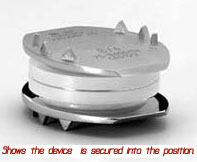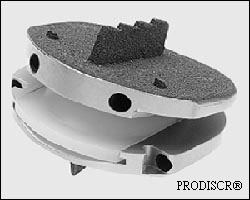|
:::
 |
 |
 |
 |

|
Intervertebral Disc Replacement |
 |
What is it? |
|
Intervertebral disc replacement is a surgical technique for the treatment of low back pain related to degenerative disc disease. Theoretical advantages of intervertebral disc replacement over fusion of the spine include preservation or restoration of segmental motion in the spine, restoration of intervertebral architecture and foraminal height, sparing of adjacent segments from abnormal stresses, and restoration of normal biomechanics across the lumbar spine.
Initial experience with composite devices in Europe suggests safety and efficacy of these devices. Prospective randomized study compared with fusion will offer an evidence-basis for the role of disc replacement in the current and future management of degenerative disc disease.
|
 |
Indications for Disc Replacement |
 |
|
 Intervertebral disc replacement may be indicated for patients with degenerative disc disease at one or two levels of the spine. Patients may be candidates for one or both of the Investigational Trials on Intervertebral Disc Replacement in the United States if they have the following conditions: Intervertebral disc replacement may be indicated for patients with degenerative disc disease at one or two levels of the spine. Patients may be candidates for one or both of the Investigational Trials on Intervertebral Disc Replacement in the United States if they have the following conditions:
- Degenerative disc disease in one or two adjacent vertebral levels between L3 and S1
- Age between 18 and 60
- Failed at least 6 months of conservative therapy
 Both devices are composite in design with a cobalt chromium alloy endplate and an ultra high molecular weight polyethylene core. Both devices have been used in Europe for over 10 years, with similar results in retrospective evaluations. In a review of patients a minimum of five years after implantation of the SB Charite disc replacement, David reported good or better results in 68% of patients. Similarly, a review of the work of Drs. Marnay and Villette using the PRODISCR in 64 patients with a minimum of seven years of follow-up demonstrated a significant improvement of back pain and leg pain (p<0.001) using a visual analogue scale, and patient satisfaction was reported as satisfied or entirely in 92.7% of patients. Both devices are composite in design with a cobalt chromium alloy endplate and an ultra high molecular weight polyethylene core. Both devices have been used in Europe for over 10 years, with similar results in retrospective evaluations. In a review of patients a minimum of five years after implantation of the SB Charite disc replacement, David reported good or better results in 68% of patients. Similarly, a review of the work of Drs. Marnay and Villette using the PRODISCR in 64 patients with a minimum of seven years of follow-up demonstrated a significant improvement of back pain and leg pain (p<0.001) using a visual analogue scale, and patient satisfaction was reported as satisfied or entirely in 92.7% of patients.
|
 |
Current Clinical Trials |
|
The efficacy of intervertebral disc replacement has not been demonstrated in prospective, randomized study. In the United States, several spinal surgery centers are participating in Investigational Device Evaluations (IDEs) with either the PRODISCR or SB Charite III Dynamic Disc Spacer. In the PRODISCR study, investigational patients will be compared to patients undergoing a combined interbody and posterolateral fusion. In the SB Charite III Dynamic Disc Spacer study, investigational patients will be compared with patients undergoing interbody fusions with a BAK device. Both studies are designed with standardized outcome assessment tools for a reliable evaluation of change in pain, function, and well-being after surgery. |
|
 |
|
 |
|